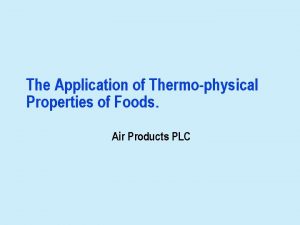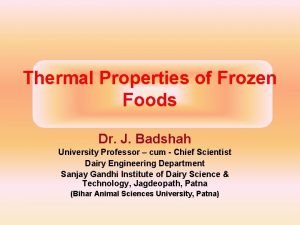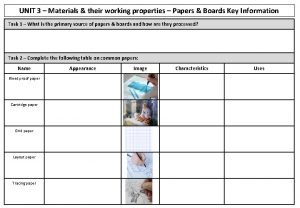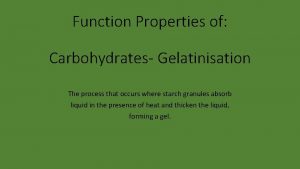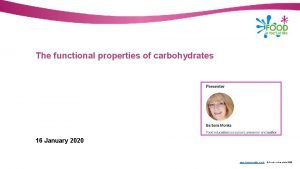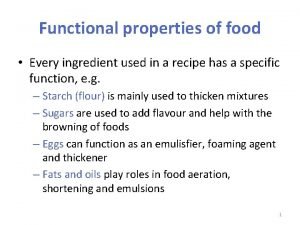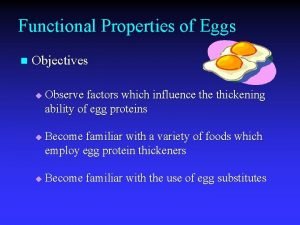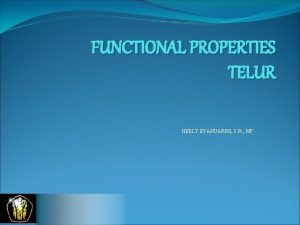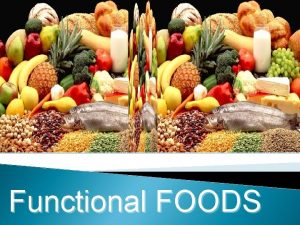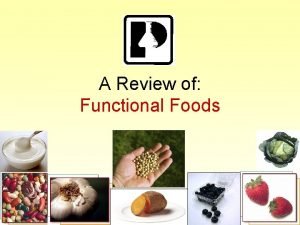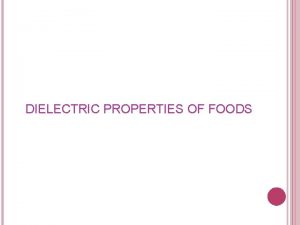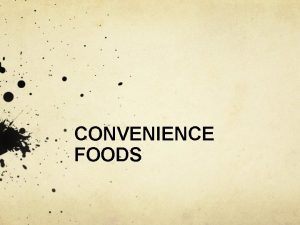Working characteristics and functional properties Foods Working characteristics



















- Slides: 19

Working characteristics and functional properties

Foods – Working characteristics and functional properties The properties of foods are important factors in considering how to prepare foodstuffs. In order to be successful in creating and designing interesting foods, it is essential to understand the processes that can be used to modify foods. The list on the right is a sample of some of the functions that are used in manufacturing foods. • Aeration • Binding • Browning • Crystallising • Fermenting • Foaming • Fortification • Glazing • Laminating • Setting • Shortening • Tenderising • Thickening

Foods – Working characteristics and functional properties • Aeration • Binding • Browning • Crystallising • Fermenting • Foaming • Fortification • Glazing • Laminating • Setting • Shortening • Tenderising • Thickening Aeration is the process of adding gas (usually air) in order to make the food lighter in texture. This can be achieved by either: • Adding liquids The liquids evaporate when cooked, releasing gas into the mixture • Adding rising agents For example, yeast produces carbon dioxide from sugar and oxygen • Whisking Traps air bubbles in foods, such as eggs

Foods – Working characteristics and functional properties • Aeration • Binding • Browning • Crystallising • Fermenting • Foaming • Fortification • Glazing • Laminating • Setting • Shortening • Tenderising • Thickening Binding is the process of making ingredients coalesce which would not normally do so. Typical ingredients used for this purpose include: • Eggs – e. g. in burgers • Flour – e. g. used in moulding burgers • Milk – e. g. to make cakes • Water – e. g. to make bread

Foods – Working characteristics and functional properties • Aeration • Binding • Browning • Crystallising • Fermenting • Foaming • Fortification • Glazing • Laminating • Setting • Shortening • Tenderising • Thickening Browning is the process of changing the colour, texture and flavour of food. There are four methods by which this occurs: • Caramelisation • Dextrinisation • Enzymic browning • Non-enzymic browning

Foods – Working characteristics and functional properties • Aeration • Binding • Browning • Crystallising • Fermenting • Foaming • Fortification • Glazing • Laminating • Setting • Shortening • Tenderising • Thickening Browning - Caramelisation When sugar is heated to above its melting point, it turns brown and gains a pleasant toffee like flavour – e. g. in crème caramel. This can be achieved in the oven, by grilling or even by using a blow torch. If it is overheated, it can burn, go black and taste sour.

Foods – Working characteristics and functional properties • Aeration • Binding • Browning • Crystallising • Fermenting • Foaming • Fortification • Glazing • Laminating • Setting • Shortening • Tenderising • Thickening Browning - Dextrinisation When starch is cooked, it browns as it turns to dextrin. Examples include bread And toast

Foods – Working characteristics and functional properties • Aeration • Binding • Browning • Crystallising • Fermenting • Foaming • Fortification • Glazing • Laminating • Setting • Shortening • Tenderising • Thickening Browning – Enzymic Browning Many fruits, such as apples and bananas, will turn brown when cut and left open to air. This is a process of oxidation. Turning from this to this! It can be avoided by blanching or covering in syrup or lemon juice.

Foods – Working characteristics and functional properties • Aeration • Binding • Browning • Crystallising • Fermenting • Foaming • Fortification • Glazing • Laminating • Setting • Shortening • Tenderising • Thickening Browning – Non-Enzymic Browning The brown colour is produced along with aromas and flavour, as carbohydrate and protein react when cooked. The outside of meat does this: Turning from this to this! Some microwave ovens have grills in them to increase the effect.

Foods – Working characteristics and functional properties • Aeration • Binding • Browning • Crystallising • Fermenting • Foaming • Fortification • Glazing • Laminating • Setting • Shortening • Tenderising • Thickening Crystallising is the process of evaporating a liquid (solution) to leave behind crystals of the solute. Consider a solution of sugar (the solute) in water (the solvent). When we heat the solution, it evaporates leaving behind sugar crystals. This procedure is used in making marzipan and caramel.

Foods – Working characteristics and functional properties • Aeration • Binding • Browning • Crystallising • Fermenting • Foaming • Fortification • Glazing • Laminating • Setting • Shortening • Tenderising • Thickening Fermenting is a biological process which produces carbon dioxide, heat and alcohol. For example, fermentation is used to make: Bread Alcoholic drinks Fermentation makes the dough rise Alcohol and carbon dioxide preserve the drink

Foods – Working characteristics and functional properties • Aeration • Binding • Browning • Crystallising • Fermenting • Foaming • Fortification • Glazing • Laminating • Setting • Shortening • Tenderising • Thickening Foaming is another name for aeration. Gas bubbles are created in the ingredients. When a meringue is made, tiny bubbles of air are created in the egg white (protein). Heating the meringue drives off water and results in the protein coagulating so that the foam remains solid, a bit like a crisp sponge. Meringues can be cooked cold by placing them in a very low pressure environment. The water evaporates rapidly and so the protein coagulates without extra heat.

Foods – Working characteristics and functional properties • Aeration • Binding • Browning • Crystallising • Fermenting • Foaming • Fortification • Glazing • Laminating • Setting • Shortening • Tenderising • Thickening Fortification is the process of enriching a food with nutrients, such as vitamins and minerals. This might be necessary if the food has suffered a loss of nutrients due to processing. Fruit juices are commonly fortified with vitamin C. Some vegetarian foods such as TVP are fortified to give them a nutritional value that is close to that of meat.

Foods – Working characteristics and functional properties • Aeration • Binding • Browning • Crystallising • Fermenting • Foaming • Fortification • Glazing • Laminating • Setting • Shortening • Tenderising • Thickening Glazing is a method of enhancing the appearance of food whilst helping to preserve it and improve its flavour. Glazes include: • Aspic • Egg yolk • Honey • Jelly • Milk • Sugar solution The surface of the food is coated with a liquid that will either set solid or turn sticky.

Foods – Working characteristics and functional properties • Aeration • Binding • Browning • Crystallising • Fermenting • Foaming • Fortification • Glazing • Laminating • Setting • Shortening • Tenderising • Thickening Laminating is a method of enhancing the appearance, texture and possibly nutritional value of food, by adding layers of different ingredients. An example might be lasagne with layers of meat sauce and pasta. The texture is characterised by the layering and the meat and vegetables add to the nutritional value of the pasta.

Foods – Working characteristics and functional properties • Aeration • Binding • Browning • Crystallising • Fermenting • Foaming • Fortification • Glazing • Laminating • Setting • Shortening • Tenderising • Thickening Setting is a method of controlling the consistency of the food. For example jams can be very thick or runny, depending on personal preferences. Setting agents include: • Cornflour • Eggs • Gelatine • Pectin • Rennet

Foods – Working characteristics and functional properties • Aeration • Binding • Browning • Crystallising • Fermenting • Foaming • Fortification • Glazing • Laminating • Setting • Shortening • Tenderising • Thickening Shortening is the addition of fats and oils to flour. This gives a crumbly and soft texture. The fat coats the flour, stopping water getting to the gluten. If the water did get to the gluten, it would tend to form into strands, producing a dough / bread like structure.

Foods – Working characteristics and functional properties • Aeration • Binding • Browning • Crystallising • Fermenting • Foaming • Fortification • Glazing • Laminating • Setting • Shortening • Tenderising • Thickening Tenderising is any process that makes meat less tough. This can be achieved by: • Ageing Naturally occurring micro-organisms start to break the meat down • Using additives • Marinating Soaking the meat in a liquid to flavour it and soften the meat The older the meat is, the more connective tissues and thicker muscle fibres are formed in it. This is what gives older meat that tough texture.

Foods – Working characteristics and functional properties • Aeration • Binding • Browning • Crystallising • Fermenting • Foaming • Fortification • Glazing • Laminating • Setting • Shortening • Tenderising • Thickening is any process that improves the consistency of liquids, such as sauces and soups. This can be achieved by adding: • Flour To thicken soups • Corn flour • Bread • Potatoes To thicken sauces To thicken soups When heated above about 80°C, the cells in the thickener rupture, having absorbed water. The starch is released and a process called gelatinization occurs, thickening the liquid.
 Functional food wikipedia
Functional food wikipedia Distal shoe appliance
Distal shoe appliance Non functional plasma enzyme example
Non functional plasma enzyme example Enzymes
Enzymes Functional and non functional
Functional and non functional Applications of colligative properties in foods
Applications of colligative properties in foods Thermal properties of frozen foods
Thermal properties of frozen foods Hot working and cold working difference
Hot working and cold working difference Hot working vs cold working
Hot working vs cold working Differentiate between hot working and cold working
Differentiate between hot working and cold working Examples of cold working and hot working
Examples of cold working and hot working Materials and their working properties
Materials and their working properties Properties of carbohydrates
Properties of carbohydrates Functional properties of carbohydrates
Functional properties of carbohydrates Examples of dextrinisation
Examples of dextrinisation Functional property of egg
Functional property of egg Functional properties dari telur adalah
Functional properties dari telur adalah Extensive and intensive properties
Extensive and intensive properties Chemical and physical properties
Chemical and physical properties Hard work vs smart work presentation
Hard work vs smart work presentation





